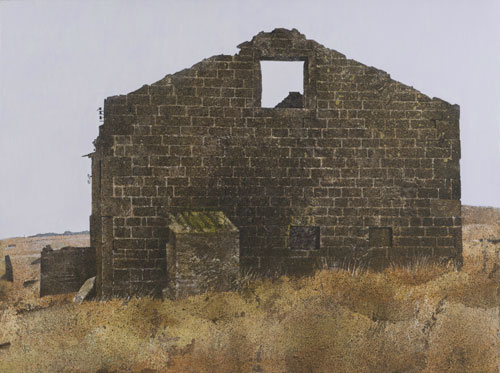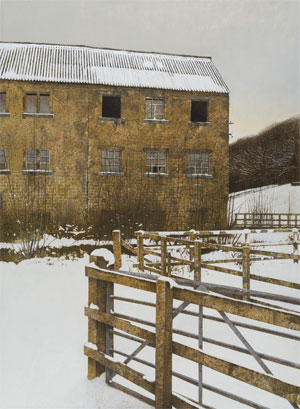Messum's Catalogue Forward 2020
It’s always interesting to watch the way an artist develops and grows. And it’s especially interesting seeing one who was once so preoccupied with the human form that as a student he studied human anatomy move away from painting figures to painting buildings instead. True, his central concern with the figure had always been the architecture of its form, with all its various positions and angles, rather than with the individual personality of the model (he was certainly never a portraitist). Yet in a way Maxwell Doig is still painting figures: in his attention to their character and individual detail, his buildings and boats and abandoned objects seem almost like individuals, in the same way Paul Nash once described trees as being like people to him, each with their own particular personality. |
|
Perhaps, then, painting people was Doig’s route to now painting the buildings he records in his distinctive, inimitable manner. Certainly he himself feels that he has brought the awareness of balance and poise gained from his early anatomical studies whilst a post-graduate student at the Slade School of Art into these new works that have preoccupied him for the last six years. Indeed, as good as his paintings of people were, in buildings he has perhaps found his true subject. As he acknowledges, he has always had a fascination with them, and he is only surprised that he didn’t start painting them sooner. It wasn’t until he was approaching his fifties that he first saw them as an appropriate subject for his art. With the growing feeling that he had taken the figure as far as he could, he was gradually losing interest in painting people. It was then that he was struck by the idea of painting buildings instead. |
 |
| He had always been interested in the shape of a suddenly glimpsed gable end, or the decayed surface and texture of the derelict factories that surrounded him in the town where he grew up and still lives – Huddersfield, in West Yorkshire. The turning point came in 2014, however, with a derelict house not far from home that particularly interested him. ‘The building itself I had always liked and photographed for years,’ he remarks. ‘The transition moment happened in the studio, when I realised I could use the surfaces and textures I normally used in the background for figures, as the central subject.’ This building became the large painting Gable End – the first of a series of studies of one side of this house viewed at different times of day and in subtly different lights. ‘It was,’ he acknowledges, ‘a turning point for me.’ And it all came so easily. When he started painting buildings he found it all perfectly natural – like he had always been doing it. So much so that it surprised him that he hadn’t started doing it much earlier. |
They were and still are often the sort of places passersby simply overlook. One of the wonders of this part of Yorkshire is the sudden transition from urban to rural: the industrial revolution kickedoff around here partly because of the easy access to water power, and large buildings can be stumbled upon in unexpected locations. ‘They’re so big many people just seem to overlook them,’ Doig remarks of the old mills that dot the landscape. ‘With the exception of Peter Brook in the 1950s and ‘60s, nobody paints them.’ One that features strongly in this exhibition is Lord’s Mill, a Grade II listed building in the village of Honley, not far from Huddersfield. Built in the early 1790s and subsequently expanded, it was in use until at least the 1950s, when its roof was destroyed by fire. It is now abandoned – boarded up and graffitied. ‘It’s like I’m the only person who’s really looked at it,’ he observes. ‘It’s nearly as old as America – it’s amazing! But it just goes unnoticed – the location’s fantastic, in a wooded valley, really romantic. It’s like a Bruegel, or one of those early painters from Ghent – valley, wood, river, rolling hillsides.’ |
 |
Certainly when seen like this they are the Modern Romantic’s equivalent of Tintern Abbey, the Welsh monastic ruins captured so famously by J.M.W. Turner in the 1790s, just when buildings like Lord’s Mill were going up (built, like Tintern, on the wealth generated by wool). And when seen up close there’s plenty there too to attract the attention of the discerning artist: old roof lines, patches of plaster, mould and decay, the sandstone of the region carrying its age interestingly, telling the stories of these places, their history, the records of past industry and past lives. These stones certainly speak. |
Doig makes a great deal of the sudden juxtaposition – so frequent in this part of Yorkshire – between the urban and the rural. Seeing his work as ‘essentially romantic’, he does not look at these buildings or the detritus of heavy industry as an intrusion upon the landscape, but rather as partners and complements to it. The Colne Valley was another of West Yorkshire’s centre of industrial activity. But as Doig remarks of the scrapheap he discovered there that is also the subject of a number of paintings and prints in this show, ‘it fits really nicely with the landscape – big chunks of heavy machinery, the abstract, geometric shapes.’ The same is true of the boats he saw on the Isles of Arran and Mull during a trip to Western Scotland in 2019: they fit neatly in to their similarly rugged landscape, one that has been the place of human habitation and activity for centuries. They are like the past life of the mills and the scrapheaps after snow – a jigsaw of pattern that reflects poignantly on former glories. |
His feeling that he was doing something worthwhile in this new direction was confirmed a few years ago when Doig discovered what he calls ‘the subtle, quiet’ work of the English painter Algernon Newton (1880–1968). To my mind, Newton was one of the finest RA’s of the twentieth century, his oddly brooding and slightly surreal paintings of urban canals, suburban houses and bare English countryside not having quite the attention they deserve – though he is highly collectable. ‘There’s a particular stillness and quality of light which resonates with me in both his landscapes and architectural works,’ Doig explains. He was particularly struck by Newton’s observation that ‘[t]here is beauty to be found in everything, you only have to search for it; a gasometer can make as beautiful a picture as a palace on the Grand Canal, Venice. It simply depends on the artist’s vision.’* This confirmed to him that he was on the right track; he now sees his purpose as capturing the grandeur of these overlooked and seemingly ordinary places before they’re pulled down. |
| But where does the comparatively little known Clough come in? Her influence is also concerned with the backgrounds, and particularly with Doig's characterisation of them as "painterly". The figures of course are, in their own way, "painterly"; but in English the term generally caries the overtone of agitated surfaces, of paint worked on, worked over, worked up. The creation and recreation of texture was something which much exercised Clough in her work, and likewise it excesses Doig. |
|
One noticeable development in Doig’s work since his previous exhibition at Messum’s in 2018 is his widening viewpoint. These recent paintings often incorporate more of the landscape, as the artist has stepped back from buildings that previously almost completely filled the frame and in which the heavily textured surface of stone and plaster could be read almost as landscapes in themselves. This widening of view in part reflects his increasing confidence and ever growing technical ability as an artist. But he has also become even more interested in atmosphere, ‘in doing more with light and mood – pushing it all a bit further,’ as he says. This concern with varying and changing impressions and effects of light and ambiance is seen most clearly in the series of paintings of the early nineteenth-century lighthouse at Flamborough Head, not far from Bridlington, on the North Yorkshire coast. This is a place he has known since first making holiday visits there as a child, and his new works advance on the paintings of the same building exhibited in 2018. As the artist explains, |
I wanted to explore it further by painting it at different times of the day and with different weather conditions. For example, Early Morning at Flamborough Head Lighthouse (dark blue sky, bright white lighthouse) is a view from the east at 6 am, summertime. Sea Fret at Flamborough Head Lighthouse (pale, misty image of lighthouse) was painted in winter, whilst Late Afternoon at Flamborough Head Lighthouse was painted in spring ... I love to paint white buildings, especially lighthouses – the way they reflect light, especially when the sky is darker than the lighthouse. It’s an exciting contrast to the sandstone buildings of my native West Yorkshire, which tend to absorb light. Alongside this, the coastal weather at Flamborough is constantly changing. The position of the lighthouse and shape of the landscape means the viewpoints and angles are many.
|
With his insatiable attention to detail and his fascination with light and atmosphere, we are reminded of another West Yorkshire artist, the Victorian painter John Atkinson Grimshaw (1836–1893). Though he particularly loved to paint by night, the parallel with Doig is most notable in the latter’s monotypes. In these one-off works such as Twilight Gable End with Trees and Winter Scrapyard in Snow Doig skillfully uses black and white to convey a deep sense of mood. They are a fantastic compliment to his colour work.
Doig is certainly not standing still. With his growing confidence together with his keenness both to continue exploring his own back yard whilst simultaneously widening his travels further afield, it is exciting to see what he will do next.
David Boyd Haycock, 2020
Author and curator
|
|